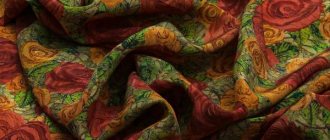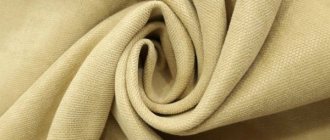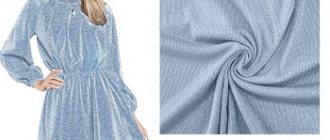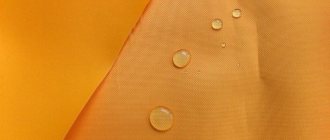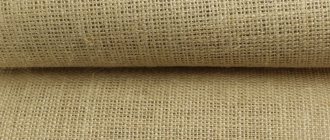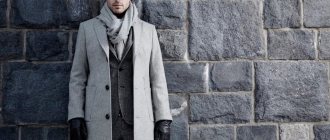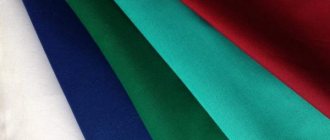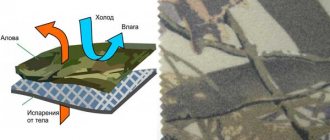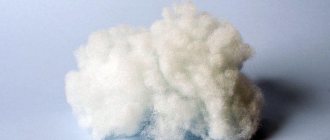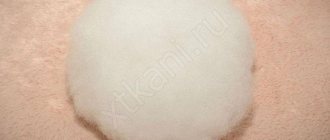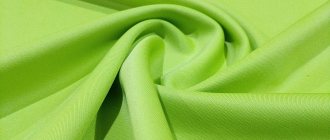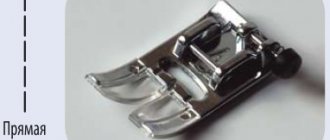Since the ecological style of interior design is trending today, the interest of needlewomen in burlap is increasing. For beginners, burlap crafts are easy to make.
The material is used for the manufacture of a variety of products related to decorative and household items. The fabric looks attractive both in a large product and in a small one, both in its natural form and with the use of decorations.
What type of fabric is this?
Burlap is classified as a technical fabric. Special purpose – packaging.
The fabric is made by plain weaving coarse, thick threads made from plant materials. The weave is made loose, resulting in a material with a porous structure and a relief surface.
Burlap colors
Raw materials for the production of threads - plants with hard bast fibers:
Hemp
Jute
Ropeman
Linen
Kenaf
In modern burlap production, not only natural but also synthetic raw materials are used: polypropylene, polyamide, polyester, viscose and others.
Mixed fabric options are also available. Thanks to different combinations of fibers, burlap with certain properties is obtained.
Bag material is produced all over the world, including in Russia. The world leaders in production are China and Canada, Pakistan and Bangladesh.
What can you make from burlap yourself?
Textiles are suitable for making home decor. You can create gift packaging from fabric; for example, wine bottles wrapped in burlap and additionally decorated with various trinkets look unusually festive.
A bag made of burlap looks original, and sewing a designer product is not so difficult. Textiles are suitable for making small bags in which you can store various things, for example, aromatic herbs.
Panels made of decorative burlap look unusual. The fabric is suitable for creating embroidered paintings.
Origin story
Burlap is one of the most ancient fabrics on Earth. In Ancient Rus', hemp was grown for its production. Not only bags, but also clothes were made from linen. Large-scale production of burlap appeared in the 19th century.
Jute material was first produced in India and Asian countries. First, ropes were made from it, and then fabric - the basis for carpets and packaging containers.
In Jamaica, poor workers made trousers and shirts from old sacks. These clothes protected both from overheating and from the wind.
The British brought jute to Europe at the beginning of the 18th century.
In America, during the Great Depression in the 1930s, used washed bags were used to make bags, towels, baby diapers and clothing. In the 40s, a fashion trend arose, colored stamps were applied to the bags, and dress patterns were sold in stores along with the bags.
Caring for burlap
Caring for the material is very simple. The packaging bags are shaken to remove dust and dried if necessary.
Clothes and accessories are machine washed and then dried thoroughly. The main rule of care is to avoid prolonged contact with moisture and dry it promptly.
Washing and drying
The fabric can be washed by hand or in a washing machine. It can withstand high temperatures; it is allowed to use any washing powders and gels.
You can bleach the fabric yourself using chlorine bleach. To do this, the fabric is soaked in undiluted white for 1–2 hours, then washed.
How to iron
The material is absolutely wrinkle-free, no need to iron it. Ironing only allows you to make the fabric more dense.
A steamer can make fabric soft. The item is hung on hangers and treated with a stream of steam from an iron or steam generator.
Tissue repair
The material is durable and quite difficult to damage. If a tear does appear in the fabric, it can be easily sewn up. You can dye the material yourself to use it for sewing clothes or for handicrafts.
For painting, powder aniline or liquid dyes are used. The paint solution is made according to the instructions. The canvas is pre-soaked in hot water and then dipped in paint. Leave for the specified time, remove and lay out to dry.
Fabric composition and its properties
The composition of the bag fabric determines the raw materials. The basis of the natural material is coarse-textured plant fibers: jute, linen.
Pure jute fabric, rough to the touch, slightly brittle. If you combine flax and jute, the bending strength increases. Cotton threads are added to soften the fabric.
Jute fabric
What are the properties and characteristics of jute fabric?
more details
Linen
Natural linen fabric - from a description of production to a review of characteristics
more details
The properties also depend on the density of the fabric, which ranges from 180 to 400 g/m2.
Main properties of burlap:
Beautiful texture
High strength
Breathability
Absorbs and releases moisture
Chemical stability and inertness
Types of fabric
Burlap is distinguished according to the composition of its raw materials:
Jute
Composition – 100% jute. Strong, rigid, resistant to mechanical damage, with a rough texture, practically does not absorb water, resistant to rotting, exposure to light and temperatures up to 300 degrees due to the lignin content.
Linen
Made from coarse flax fiber. The fabric is soft, light, thin. Easy to paint, natural antiseptic.
Mixed
The ratio of jute and flax is 50% to 50%. Durable, dense. Softer than jute, but stiffer than linen.
Hemp
Made from hemp or hemp threads. The fibers are stronger than cotton and linen. Withstands boiling and regular washing, does not rot in high humidity conditions.
Cotton
Hygroscopic, lightweight, hypoallergenic. Used in a mixture with flax or jute.
Laminated
Rough jute or linen burlap is coated with polypropylene impregnation, wear-resistant and impervious to moisture.
Synthetic
Packaging fabric made of synthetic or artificial threads. Outwardly it looks like natural one. Not environmentally friendly.
Decorative burlap for needlework
Burlap products - various figures, flowers, unique flower pots, wreaths and butterflies - look simple but extremely original at the same time. They can be given as a memorial token for any date or just for no reason. But this gift will always be accepted with pleasure. It will be impossible to take your eyes off the craft. Whether it be embroidery or a full-fledged painting made of colored burlap - everything will not only decorate the interior, but will also bring joy to its owner.
How to make a gift from burlap
For handicrafts, jute fabric is most preferred.
Note! Although it is rougher, it has a special texture. This is why the craftswomen love her.
Gift for March 8th - a flower made of burlap and coffee beans
For manufacturing you will need the following materials:
- sackcloth;
- leg-split;
- coffee beans;
- aluminum wire thin and thick;
- glue gun, scissors, pencil;
- rubber ball, Kinder surprise capsule;
- gypsum, water, dilution container, spoon;
- pot, small stones.
Manufacturing procedure:
- Draw templates for the petals on a piece of paper and cut them out. Draw the center of the future flower on cardboard and cut it out.
- Trace the petals on the burlap according to the template; you need to make 6 pieces in total.
- Using a glue gun, glue twine along the contour of the petals. Also glue a piece of twine along the middle of the petal. Glue half a coffee bean to the top.
- Carefully cut out the petals along the edge.
- Glue the petals one by one to the cardboard center, gluing them with an overlap.
- Using hot glue, cover half of the rubber ball with grains. After the glue has hardened, squeeze the ball and carefully pull it out. It should look like a coffee “cup”.
- Glue it to the petals in the middle.
- Wrap pieces of thin wire 20 cm long with twine - these will be twigs.
- For the stem, take a thick wire 35 cm long, fasten half of the capsule on it and wrap it and the stem itself with twine. While working, wrap branches around the stem.
- Glue the stem to the petals with a coffee center.
- Dilute the plaster with water. Pour pebbles into the bottom of the pot, install a stem with a flower and fill everything with plaster.
You might be interested in what double-thread means: description and use of Turkish fabric
Note! The result will be an original gift that can be additionally decorated with burlap - either the pot itself, or make more flowers using the same pattern and glue them to the branches.
Flower made of burlap and twine
Pros and cons of fabric
Natural burlap has many advantages:
- resistant to mechanical damage and rupture;
- hygroscopic, but dries quickly;
- not damaged by insects and rodents;
- easy to care for;
- environmentally friendly;
- can be painted;
- pleasant natural color;
- low price.
The disadvantages of the material include:
- instability to prolonged exposure to a humid environment;
- flammability.
What is the name of the fabric that looks like burlap?
A fabric similar to burlap is called canvas. The difference between the two flaps is difficult to find, since they are not critical. The quality characteristics are almost identical. But canvas feels rough, but can be used in clothing. But burlap has a higher density. There are no other differences. Both products are used in different areas: clothing, agricultural packaging, accessories.
What standards are used in production? What do they take into account?
Manufacturing standards and material quality are established by GOST 5530-2004.
The density of the weave of the threads is the key technical characteristic of burlap and lies in the range of 180 - 400 g/sq.m. meter. It depends on the number of warp and weft threads per 10 cm of fabric.
In loose samples the ratio is 26x25, in dense samples it is 69x63. Density is calculated by weighing. Weight per square meter of natural fabric is from 190 to 450 g, synthetic - from 48 to 200 g.
The standard width of burlap is 95, 106 or 110 cm.
Outfit for a child
A children's suit is sewn just like an adult's. You just need to make a smaller outfit.
It is better to use more bright details for it. The baby will be delighted with the DIY Baba Yaga children's costume.
All elements should be carefully thought through. Don't make your outfit wide and long. The child should be comfortable in it.
What purposes can this fabric be used for?
Burlap is a unique material that has enormous application potential:
Packaging - bags for transportation and storage of bulk cargo, food and agricultural products.
Construction - filters for water and technical fluids, wall decoration, sound insulation, shock-absorbing material.
Furniture production - upholstery material for upholstered furniture, mattresses.
Forestry, gardening - protection of seedlings, covering of lawns, protection against soil erosion.
Design - interior decor, creating stylish clothes and accessories, gift wrapping, hand-made goods.
Scope of application of burlap
Initially, burlap was used for packing things. It was used to make bags for bulk products, to wrap fragile items and bottles. Parcels and letters were wrapped in burlap, with a wax seal placed on top.
Gradually, the scope of application of the fabric expanded. Now it is actively used in the interior:
- for finishing walls and ceilings;
- furniture design;
- sewing tablecloths, sofa cushions, curtains.
Finishing with burlap creates an atmosphere of country housing, comfort and tranquility.
Burlap clothing is a special branch of fashion. Dresses, sundresses, skirts, and jackets are made from coarse fabric. Mostly linen is used, as it is the softest.
There is an interesting fact associated with burlap clothing. At the beginning of her career, Marilyn Monroe posed for a women's magazine. There was criticism against her photographs that all the beauty of the actress lies in her flashy outfits, and she would try to look beautiful in a potato sack.
A few days later, a new photo shoot of Monroe appeared - she was wearing a dress made from a potato sack. The actress looked no worse than in a designer outfit.
Various accessories are made from the material - backpacks, bags, hats, hair decorations. Embroidery on rough fabric creates an original style.
Burlap is used for fishing and hunting. Camouflage fabric is made of jute, painted in sand, gray, green colors. It is used as a camouflage covering for traps, huts, and tents.
Canvas with a seamless texture are used by artists to create paintings. The colors on it look different than on canvas, and the paintings acquire volume. The material is used to make theatrical scenery and costumes.
The material is used in construction and industry. It is used to make a filter for various liquids. The walls are covered with fabric for sound insulation and surface leveling.
The material is used in needlework to create various decorations. It makes original packaging for gifts and flower bouquets. Drink bottles wrapped in burlap look beautiful. Pieces of fabric are used in making cards and toys.
You can even make flowers from burlap and decorate gift boxes, tablecloths, and curtains with them. They also sew small bags for storing spices, aromatic herbs, and coffee beans. Similar bags are made by the Ecology Light store.
New Year's wreaths and garlands made of rough fabric look beautiful. Embroidery fits well on canvas, so panels and embroidered paintings are made from it.
When cut, the edges of the canvas crumble. Finishing the edges can be difficult because the fabric is stubborn and doesn’t bend well. Usually the edges are left unhemmed, soaking them in a solution of PVA glue.
See how to use fabric in decoration:
